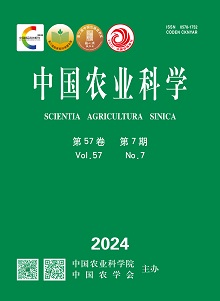【Objective】 Sorghum is the fifth largest cereal crop in the world, which has a variety of usages. Compared with other crops, sorghum has a strong drought resistance, drought has become one of the main restricting factors in sorghum (especially grain sorghum) production, with the intensification of the global drought. Through drought resistance identification and classification index evaluation of grain sorghum materials were carried out in order to lay foundations for future studies on molecular mechanism of and breeding for drought resistance in sorghum. 【Method】 With 165 grain sorghum accessions as the experimental materials, drought resistance experiments with two treatments, drought (DS) and normal irrigation (NI), were carried out in the fields in Shanxi and Hainan provinces. Eight morphological traits, including plant height, panicle length, stem diameter, leaf greenness, lodging rate, 1000-grain weight, grain size and yield, were investigated. Cluster analysis was carried out by using three methods: Comprehensive Drought Tolerance Coefficient (CDTC), Drought Resistance Index(DI) and membership function(D).【Result】 Under drought stress, all 8 morphological indexes of grain sorghum decreased. Except that leaf greenness was not correlated with plant height and grain size, and lodging resistance was not correlated with panicle length and grain size, all the other indicators were correlated to some extent. Five high-resistant accessions (L013, SX44B, sx18-25, sx18-87 and L405) and 4 sensitive accessions (sx18-46, sx18-82, sx18-96 and sx18-73) were selected according to the three comprehensive drought resistance evaluation methods; According to the relative value and variation coefficient of morphological indicators, the experiments in both places showed that the stay-green, yield, grain size and lodging resistance were sensitive to drought, and there was overlapped information among the four indicators. According to the principal component analysis, yield, plant height and grain size were the main factors determining the first principal component, and the contribution rate was 31.841%; The greenness of the leaves and thousand-grain weight were the main factors determining the second principal component, and the contribution rate was 20.441%; Stem thickness were the main factors determining the third principal component, the contribution rate was 13.557%; the main factors determining the lodging resistance of the fourth principal component, the contribution rate was 11.428% ; The fifth principal component was spike length, the contribution rate was 9.461%. 【Conclusion】 It was found that drought stress at the middle and late growth stages had significant effects on the main morphological indicators of grain sorghum. There existed significant difference among accessions in drought resistance. Combined with three comprehensive evaluation methods of drought resistance, the drought resistance of sorghum accessions could be evaluated more accurately. Two traits stay green and yield could can be used as main morphological indicators to evaluate drought resistance of sorghum after flowering.











